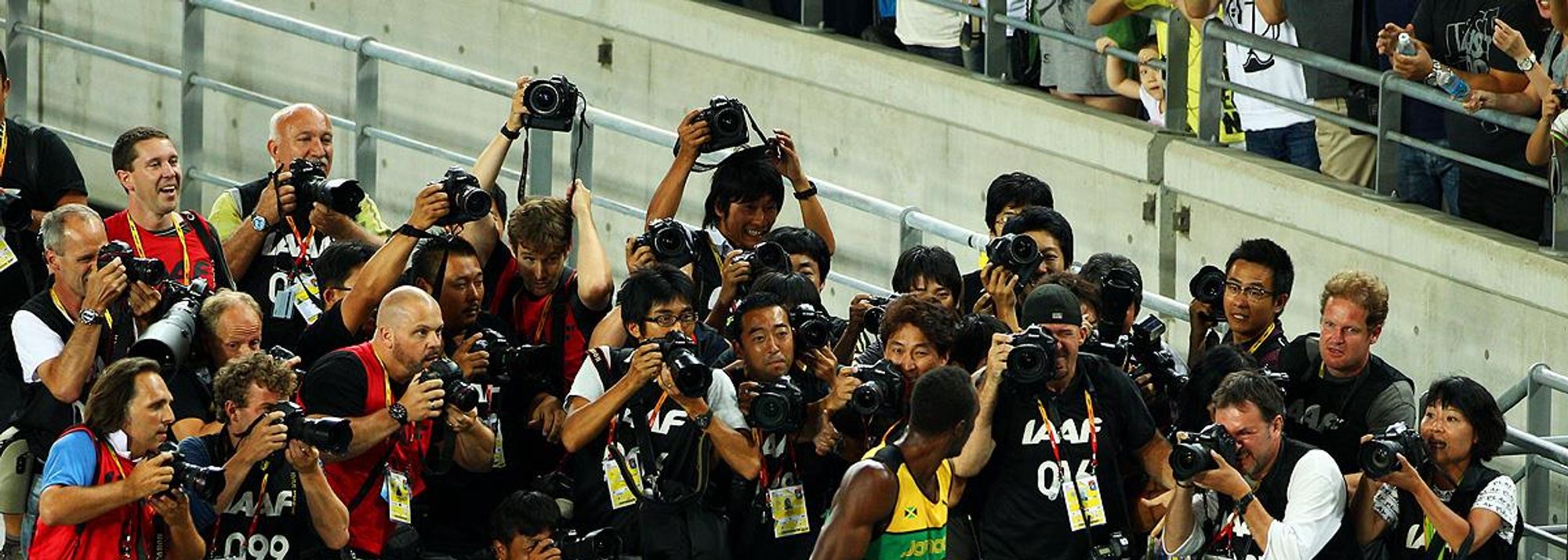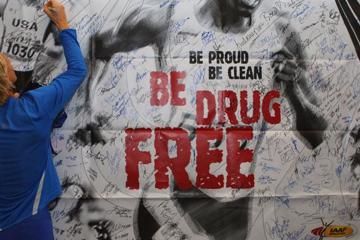Photographers surround Usain Bolt at the IAAF World Championships (© Getty Images)
For Steve Rose, Getty Images Director of Photography for Sport, the IAAF World Championships has always been “a big one” on his schedule of major events. The forthcoming 15th edition in Beijing will be no exception.
Rose, who has overseen each and every IAAF World Championships in a variety of roles working for the IAAF's official supplier of photos, says demand for images has never been higher and Getty will be sending a record number of staff to attend the Bird's Nest Stadium to meet these needs.
“It (the World Championships) is a great event and this year we will be sending our biggest team ever,” explains Rose. “The IAAF is asking for even more content and the only way we can guarantee delivering this is by sending more people. This year we'll have up to eight photographers and 10 back-up crew – three more than we sent in Moscow (at the 2013 edition). We've also asked for seven seats in the tribune, which is a record.”
With the Getty staff in Beijing hailing from Europe, North America, Australia and their local Beijing office, the iconic photographic giants will be drawing upon a crack pan-global team to ensure the best possible images will be provided.
The crew will be given a detailed daily brief to supply photographs for their dozens of news clients around the globe. Meanwhile, Getty Images will also be servicing the IAAF, who this year are seeking even more extensive coverage of athletes from the smaller countries to further enhance media profile from the biennial event.
With Getty Images coverage extending to press conferences and the IAAF Congress – which this year includes the announcement of the new IAAF President – plus a number of other peripheral commitments, this will place a heavy demand on the team.
“One of the biggest challenges is fatigue,” admits Rose, who will be leading Getty's photographic team in Beijing. “The days can sometimes be 14 hours long. It is full on and we expect the weather to be pretty hot as well. Fatigue can play a part and that is a challenge, but that is also why we have more staff at this year's event.”
Rose recalls that images taken at the Bird's Nest Stadium during the Beijing 2008 Olympic Games were spectacular and he is similarly confident the iconic venue will enable his team to shape the visual legacy of the nine-day competition in the best possible way.
A reconnaissance trip to Beijing earlier this year by one of his team revealed that the photographic set-up in stadium has remained virtually identical to the Olympic Games. “The way the stadium is set out in terms of space and the positions around the moat are great in terms of allowing the photographer to get what they need,” said Rose. “The stadium has a good shape to it, which works perfectly for athletics.
“The light is good, which makes life easier to get the best possible coverage, and I also think the crowds will be good, which is another tick in the box in terms of getting the best pictures of the event. Meanwhile, the unique facade of the Bird’s Nest will make for some great shots outside of the stadium.”
Rose does not anticipate the IAAF World Championships in Beijing will witness any major photographic technological innovations. However, he is hopeful the use of robotic cameras – first used at the 2013 World Championships in Moscow – which will be rigged up to the roof in the Bird's Nest Stadium, will prove a bigger hit in Beijing thanks to better positioning, angles and composition.
Traditionally events such as the steeplechase, the jumps and the throws “with the emotion on the athletes’ faces at time of release” provide great images. However, Rose admits the key event for Getty to deliver on will be the men’s 100m final on August 23.
“The race is on to be the first picture agency to get that first picture out of the 100m winner crossing the line,” he explains. “We know many people in the world on various platforms will be waiting for that first picture for the men's 100m final to come through. If we get that one right, then the whole team is given a lift. It is a great buzz.”
Yet although the layout of track and field has remained similar throughout the rich 32-year history of the event, he believes the ambition of his photographic team should be strive for an innovative approach to help tell the World Championships story.
“We are looking for that different angle, different approach or different composition,” he explains. “If we provide something a little different we keep that momentum moving forward to the next championships.”
Steve Landells for the IAAF






